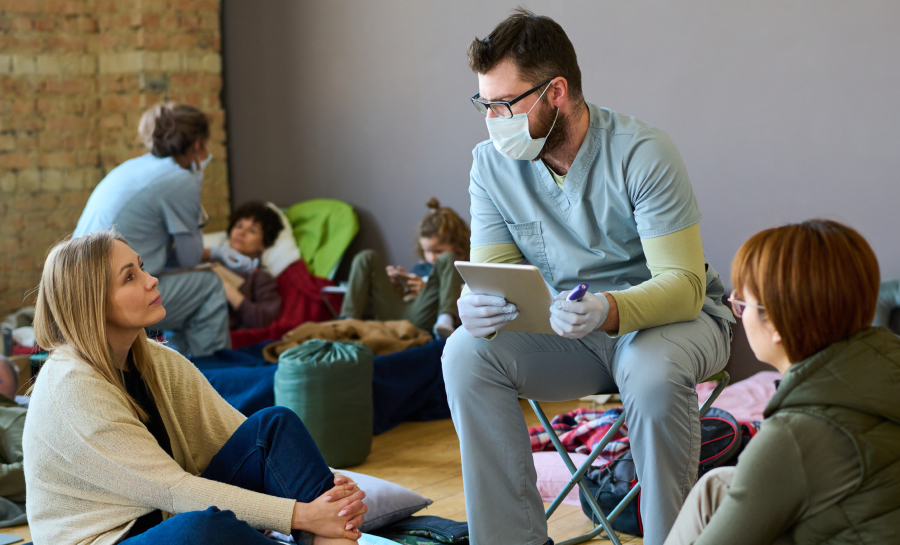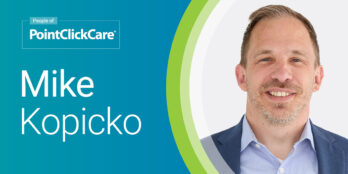
Leveraging Health IT for Disaster Preparedness and Response
 5 min
5 min
So far this year, the Federal Emergency Management Agency, or FEMA, has documented a total of 57 declared disasters across the United States. Natural and human-induced disasters like these often cause disruptions in routine healthcare, including patient displacement and hospital evacuations. Knowing these realities, it’s imperative for healthcare organizations to adopt innovative approaches to disaster preparedness and response.
To better understand disaster activations and how instrumental health IT solutions have been in streamlining response efforts, PointClickCare’s Lauren Knieser, Senior Director of Customer Success, and Kate Jackson, Product Director, sat down with George Gooch, CEO at Texas Health Services Authority, and Suzanne Kirayoglu, Health Information Technology Project Manager at the Florida Agency for Health Care Administration, for their first-hand perspectives and important insights.
Collaboration and Partnerships
Throughout the episode, both George and Suzanne emphasized the importance of collaboration and partnerships in disaster preparedness. Working closely with various agencies, emergency responders, and healthcare facilities is crucial in establishing effective response plans and ensuring that everyone is aligned when disaster strikes.
“We provide access to health IT solutions like PULSE, or the Patient Unified Lookup System for Emergencies, in Texas so emergency personnel have access to the electronic health information they need to help better patient outcomes in these alternate care sites during disasters,” George explained. Embracing this solution greatly improved the state’s collective disaster response.
Suzanne discussed Florida’s parallel journey, from manual processes during Hurricane Michael to the streamlined use of technology during Hurricane Ian. The two emphasized the need to build strong relationships with emergency responders to enhance disaster response efforts and ensure the continuity of patient care outside of routine healthcare environments.
Improving Disaster Response Processes
Suzanne highlighted the significance of having efficient processes in place during emergencies. “While technology plays a vital role,” she said, “it must be accompanied by well-established protocols and clear communication channels to ensure a smooth response.” Lessons learned from previous disasters, like Hurricane Michael and the Surfside Condo collapse, have driven improvements in Florida’s emergency patient directory — the E-Plus system — and their development of relationships with key stakeholders.
The Value of Health IT Solutions
George shared how health IT solutions including PULSE have been transformative in disaster response. These tools provide real-time access to critical patient data, allowing healthcare providers and emergency responders to make informed decisions quickly. He saw this real-world impact during Hurricane Ian, when the PULSE network enabled the reunion of a daughter and her father in an assisted living facility.
“During an emergency, there are always people who are concerned about the whereabouts of their loved ones or can’t remember their meds. The ability to figure out what’s going on, look up their diagnosis, and help them feel safe has been a heartwarming aspect of working on this project,” he said.
Bridging Information Gaps
The podcast episode also addressed the challenges of interoperability and data sharing during disasters. Despite advancements in security and technology, hesitancy to share data remains a concern. Both security concerns and competitive factors contribute to a wider health data gap over time, and addressing these challenges is essential to improving the overall efficiency of disaster response efforts.
“There’s still more work to be done to ensure that the right data is readily available in response to a disaster. In Texas, it’s our job to help everyone see the value prop in the PULSE network to be able to help these patients during their most vulnerable times — this is a lofty goal that we’re hoping to accomplish over the next five years,” George explained.
Building Trust and Engagement
Ensuring trust and engagement within the healthcare ecosystem is vital in encouraging patients to seek follow-up care and leverage available tools for their long-term wellness. Providers and payers need incentives to engage with each other, such as automating the process of sharing patient data or embracing value-based care contracting.
Kate further underlined the importance of continuous learning from partner states’ experiences, allowing for the discovery of new ways to apply health IT tools to solve unique challenges during disasters. “Our Oregon partners found an interesting use for our patient search tool recently during the Oregon wildfires,” she explained. “They knew that they had high-risk, high-needs patients because they were able to access information about patients who were dependent on electricity for devices or medications and had a general idea of where those patients were located within the wildfire path line. But they weren’t sure they had the correct contact information or information on the specific medical challenges those patients were facing. They were able to use our patient search tool to confirm that information and do proactive outreach to better support those patients.”
This latest episode shed light on the tremendous progress made in leveraging health IT for disaster preparedness and response. Collaboration, innovation, and continuous improvement are essential elements in developing robust response plans that save lives and protect communities in times of crisis. As the industry continues to evolve, the key takeaway should be to prioritize building strong partnerships and implementing efficient processes that embrace technology to its fullest potential.
To learn more, listen to the full podcast episode on Collision Point, PointClickCare’s podcast.
August 30, 2023






